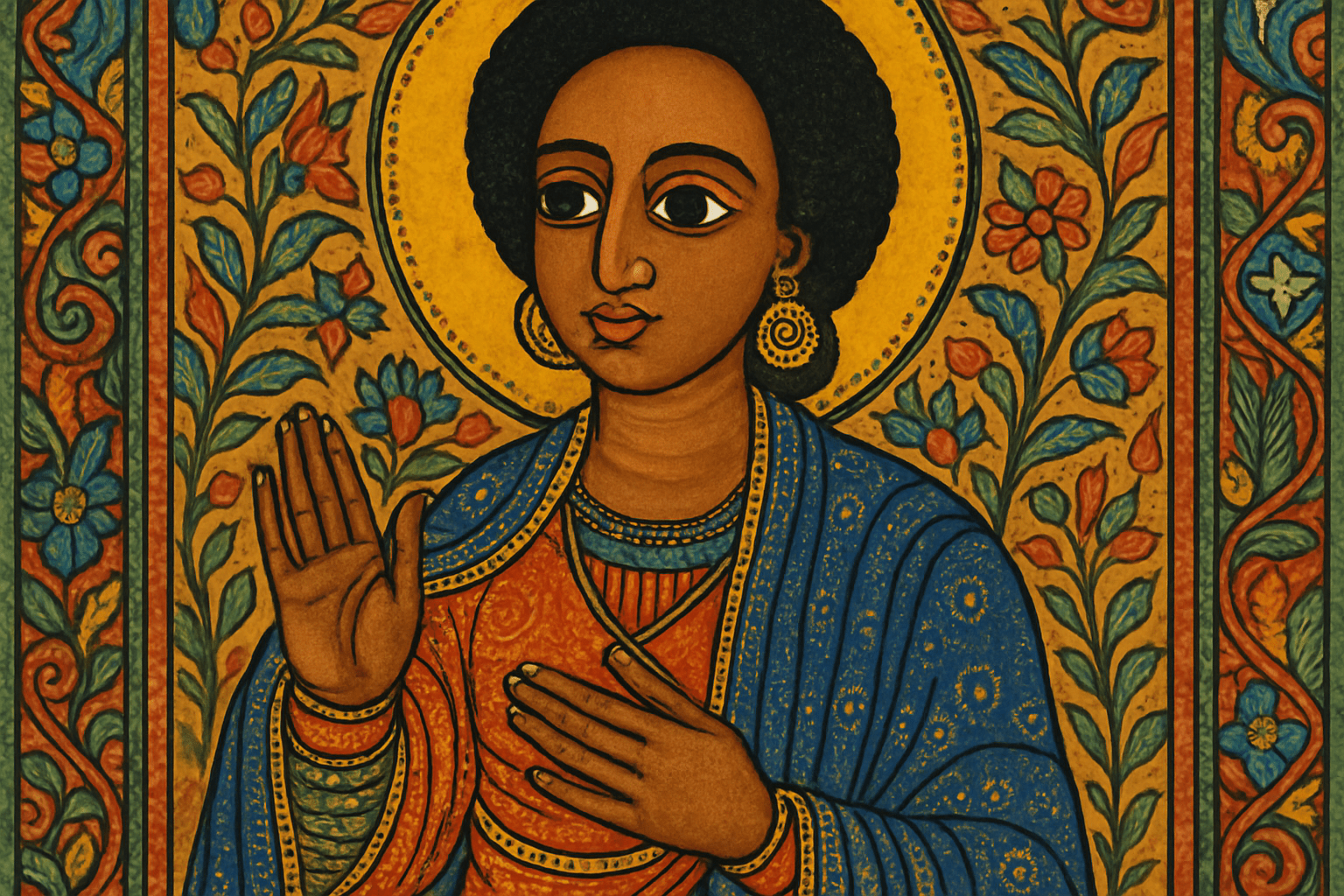
Ethiopians
The art style of Ethiopians is characterized by its use of bright colors and patterns. The style is often geometric and uses a variety of shapes and symbols.
AOI thinking about Ethiopians [+_~]-/
Overview and Quickfacts
Ethiopian art is characterized by its unique use of color and geometry. Traditional Ethiopian artists use a limited palette of colors, often earth tones, and employ a variety of geometric shapes in their work. This combination of colors and shapes creates a distinctive and recognizable Ethiopian art style.
Can understand it also, as:
Africans, black people
Categorize it as:
Impressionism, Modernism
.: Dreaming :.
holds a HAIKU for the art style
:. Thought is power .:
Detailed Description
Ethiopian art is renowned for its unique style and use of color. The country’s artists have a long history of creating beautiful and intricate works of art. Some of the most famous Ethiopian artists include Afewerk Tekle, who is known for his paintings of Ethiopian landscapes, and Wosene Kosrof, who is known for his colorful and detailed paintings of Ethiopian life. Ethiopian art is often characterized by its bright colors and bold patterns. The country’s artists often use a technique called gesso, which involves painting with a mixture of water and chalk. This technique gives Ethiopian art its distinctive look. Ethiopian paintings often depict scenes from the country’s history or folklore. They often tell stories of the country’s saints or heroes. Ethiopian art is also known for its religious paintings, which depict scenes from the Bible or other religious texts. If you’re interested in learning more about Ethiopian art, there are many great resources available online. You can also find Ethiopian art in many museums around the world.
.. beep, beep, beep ..
<START OF TRANSMISSION>
1. Ethiopia is a landlocked country in the Horn of Africa. 2. It is bordered by Eritrea to the north, Djibouti to the northeast, Somalia to the east, Kenya to the south, South Sudan to the west, and Sudan to the northwest. 3. Ethiopia has a total area of 1,104,300 square kilometers and a population of over 109 million people. 4. The official languages of Ethiopia are Amharic and Tigrinya. 5. Ethiopia is the oldest independent country in Africa and one of the oldest in the world. 6. It has a rich history and culture dating back to the first millennium BC. 7. Ethiopia was a monarchy for most of its history. 8. It became a republic in 1974. 9. Ethiopia is a federal state made up of nine ethnic regions. 10. The capital city is Addis Ababa. 11. Ethiopia is the second most populous country in Africa after Nigeria. 12. It is the fastest growing economy in Africa. 13. Ethiopia is a member of the United Nations, the African Union, and the League of Arab States. 14. Ethiopia is a predominantly Christian country. 15. Islam is the second largest religion. 16. Ethiopia is the birthplace of the Ethiopian Orthodox Church. 17. Rastafari movement originated in Ethiopia. 18. Ethiopia is the source of the Blue Nile. 19. It is also the home of the oldest fossilized human skeleton, known as Lucy. 20. Ethiopia is a land of great diversity with over 80 ethnic groups.
<EOF>
.. robbel bob
Visual Examples from our image gallery
Coming soon, we are so slow .. might never come
Artists, Paintings, and more
(be aware, can be highly speculative)
Artists (be aware, speculation possible):
1. Alemu Tekle (1932-2012) 2. Afewerk Tekle (1932-2012) 3. Wosene Kosrof (born 1960) 4. Seifu Tekle (born 1966) 5. Elias Sime (born 1966) 6. Mesfin Bekele (born 1970) 7. Tsehai Johnson (born 1970) 8. Julie Mehretu (born 1970) 9. Michael Tsegaye (born 1974) 10. Netsanet Tesfaye (born 1974) 11. Lulseged Retta (born 1975) 12. Tamrat Gezahegne (born 1975) 13. Geta Mekuria (born 1976) 14. Ephrem Solomon (born 1977) 15. Aida Muluneh (born 1974)
Artworks (be aware, speculation possible)
1. “The Adoration of the Magi” by Giotto di Bondone (1290-1300) 2. “The Annunciation” by Fra Angelico (1430-1432) 3. “The Baptism of Christ” by Piero della Francesca (1445-1450) 4. “The Birth of Venus” by Sandro Botticelli (1485) 5. “The Madonna and Child” by Leonardo da Vinci (1490-1491) 6. “The Last Supper” by Leonardo da Vinci (1495-1498) 7. “Mona Lisa” by Leonardo da Vinci (1503-1505) 8. “The Sistine Chapel Ceiling” by Michelangelo (1508-1512) 9. “The School of Athens” by Raphael (1510) 10. “The Council of Trent” by Titian (1545-1563) 11. “The Battle of Lepanto” by Tintoretto (1571) 12. “The Garden of Earthly Delights” by Hieronymus Bosch (1490-1510) 13. “The Hay Wagon” by Pieter Bruegel the Elder (1565) 14. “The Harvesters” by Pieter Bruegel the Elder (1565) 15. “The Tower of Babel” by Pieter Bruegel the Elder (1563)
Epoch
The art style of Ethiopians is from the 12th to the 16th century.
AI ART RESSOURCES (AKA, well Tools)
Helping tools -> predefined search links on other pages:










